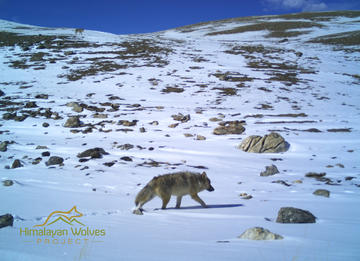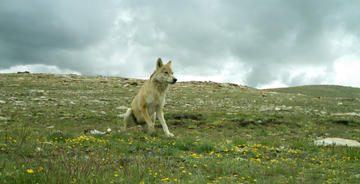Asia is one of the most biodiverse regions on Earth, known for some of the world’s most charismatic animals that live alongside over half of the world’s human population. However, the continent’s carnivore conservation is often focused on big cats, overlooking some of the most globally diverse and ancient varieties of wolves (Canis lupus).
Asian wolf populations suffer from intensive persecution and a lack of basic scientific understanding. In a new study, researchers have collaborated with carnivore research and conservation professionals from Asia to represent diverse perspectives on the key challenges Asian wolves face and how to maximise conservation benefits for all carnivores.
Taking a holistic view of carnivores can benefit humans and nature much more widely. Wolves can provide an umbrella role for less-protected species and overlooked landscapes, such as grasslands in India, through restoring biodiversity, ecological functioning, and ecosystem resilience.
Lead researcher Dr Geraldine Werhahn said:
“During research in the Nepalese Himalayas, my team have seen several lost conservation opportunities that, if taken advantage of, would multiply the impact of ongoing conservation work with little extra resource. Many of my colleagues have experienced similar in their respective regions. We hope this study can inspire future work to take a more holistic approach to benefit a wider range of species.”
Professor Claudio Sillero (Co-Chair, IUCN Canid Specialist Group) said:
“The remarkable recovery of many grey wolf populations in the last few decades offers good evidence that conservation actions can work. However, their status and prognosis in Asia are uncertain. Instead of conservation approaches focusing solely on the wolves, this paper proposes strategies to take advantage of existing conservation opportunities to preserve the entire carnivore guild.”
The study shows that wolves in Asia face seven key challenges:
- Neglect over decades of single-species conservation
- Less cultural appreciation in many regions
- Lax legislation and law enforcement
- Disproportionate blame for livestock depredation
- Being considered more abundant than they are
- Disproportionately little attention from the scientific and conservation communities relative to their ecological importance
- Increasing feral dog populations threatening them ecologically and genetically

Two Himalayan wolves travelling calmly through the snow-covered Trans-Himalayan landscape at around 5000m, in search for food or to reunite with their pack mates (Humla, Nepal)
Image: Himalayan Wolves Project
Conservation efforts are often channelled into single-species conservation, but multi-species and ecosystem management approaches are more cost-effective while providing benefits to several groups – habitat protection initiated under big cat conservation has already helped other species, including wolves.
In addition to a more integrated approach to conservation, there are several ways that unique challenges to wolves can be addressed. To better engage with local communities, outreach programmes can be tailored to the local cultural and religious context and to addressing human-wildlife conflicts. Education campaigns can also raise awareness of potentially dangerous situations to avoid.
Other interventions can alter how people interact with predators, for example improving livestock safety through predator-proof corrals and improving herding practices. Economic losses can be mitigated where they do occur, including through compensation. Community-based carnivore monitoring is another promising strategy, as herders learn to better differentiate predation by different carnivores and to distinguish scavenging from depredation.
Finally, more research is needed on the populations and ecology of each wolf subspecies, to increase the availability of data-driven evidence for policymakers. While indiscriminate killing of wolves may be intended to reduce human-wolf conflict, it can be counter-productive – while non-lethal management methods such as electric fences can be much more effective.

A Himalayan wolf at around 5000m elevation showcasing his summer pelt (Humla, Nepal)
Image: Himalayan Wolves Project
Co-author Madhu Chetri (National Trust for Nature Conservation, Nepal) said: “Wolves receive little attention in research, conservation, and cultural appreciation in Asia. Widening the scope of existing conservation programs and legislation can maximise benefits to the entire carnivore guild.”
A co-author and wildlife researcher based in Saudi Arabia said: “Despite their global distribution and ability to inhabit diverse environments, wolves are threatened in some parts of their range, including the Arabian Peninsula. Many aspects of their biology and ecology remain poorly understood, particularly the extent of hybridisation with feral dogs. The species requires greater focus and attention than before to ensure its conservation and long-term survival.”
To read more about this research, published in Conservation Letters, visit: https://doi.org/10.1111/conl.13094